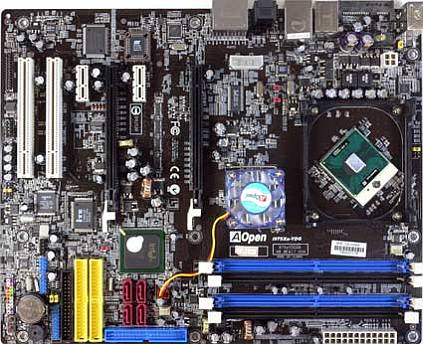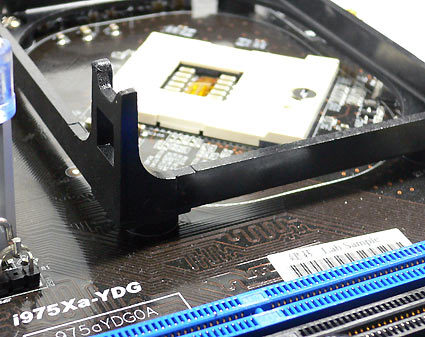Dual Core Processors For Low-Power, High-Performance Desktops
... And AOpen I975Xa-YDG
We already reported on the AOpen Core Duo motherboard in March and our first impressions were positive: Core Duo pairs good performance with very low energy requirements. The 975X, however, is not what we would call an efficient chipset, which is documented by our measurements of 70 to 93 W. The i975Xa-YDG is a full-featured motherboard that leaves nothing to be desired, and even supports ATI Crossfire dual graphics thanks to its two x16 PCI Express slots.
Our CPU-Z utility displayed inaccurate memory timings - while the system was running CL3.0-2-2-8 settings for the DDR2 memory, CPU-Z reported CL3-2-2-12. The implementation of Intel's SpeedStep feature also does not seem to be mature yet, because we observed some strange benchmark results when SpeedStep was enabled. The MP3 encoder LAME took seven minutes longer, WinRAR extended its compression process by one minute, and F.E.A.R slowed down by 13 frames per second. Though there are marginal performance losses when SpeedStep is enabled, these differences can only be explained by the system failing to speed up the CPU after having slowed it down earlier. We are sure that this issue can be fixed by a BIOS update.
In F.E.A.R. (without SpeedStep), the Core Duo system managed to outperform the gaming specialist Athlon 64 X2 by providing higher minimum frame rates. File compression is faster on the Core Duo as well, while we are looking at a neck-and-neck race in both video encoding (Pinnacle Studio) and transcoding MPEG-2 to MPEG-4 DivX or XviD. Here, Core Duo is slightly faster, but you should also consider that it requires 43% less energy than the Athlon 64 X2. Even if you upgraded the AMD system with a dedicated graphics card for the sake of a fair comparison to the AOpen/Core Duo system, the latter would still be 22% more efficient! But there is one catch: the Core Duo T2600 is currently at least twice as expensive as an Athlon 64 X2 3800+.
AOpen's box is stuffed with the usual suspects: there are all required UltraATA and SATA cables, a manual, a driver disc and a processor cooler, which runs quietly. Unfortunately, the board does not have sophisticated overclocking features beyond manipulation of the FSB and the core voltage. It would be ideal to set the system clock from FSB667 (166 MHz quad-pumped) to FSB800 (200 MHz), which really could speed up Core Duo (assuming that it worked, of course!)
Get Tom's Hardware's best news and in-depth reviews, straight to your inbox.
Current page: ... And AOpen I975Xa-YDG
Prev Page The Heir Apparent: Intel Core Duo T2600 Next Page AOpen I975Xa-YDG, Continued
Patrick Schmid was the editor-in-chief for Tom's Hardware from 2005 to 2006. He wrote numerous articles on a wide range of hardware topics, including storage, CPUs, and system builds.


